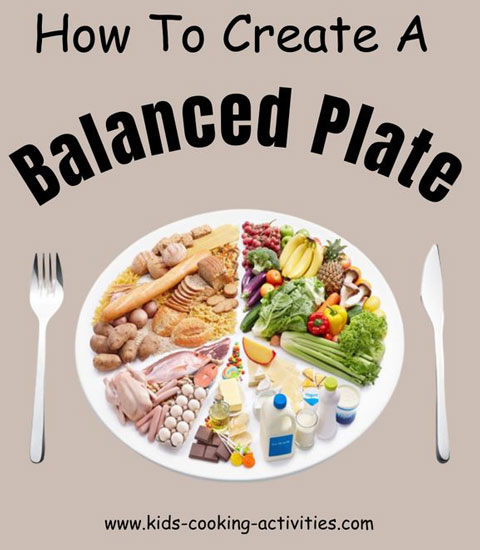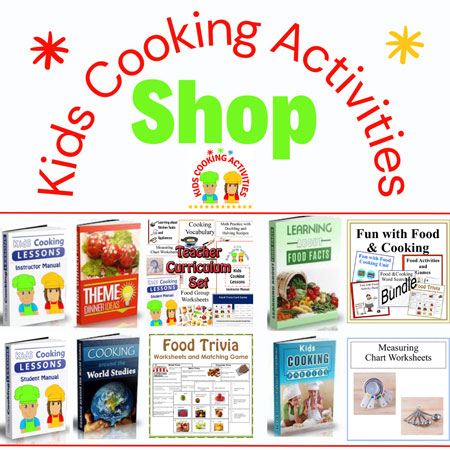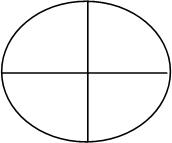What is a Kids Healthy Portion Size?

A healthy portion size is simply how much food you should be consuming. It is important to remember a kids portion size, an adult portion and a teenagers portion is going to be completely different. When serving your family and creating healthy meal plans, try to keep this in mind. This page is to help you understand the "right" portion size for your kids and how much calories your kids should be getting each day.
Kids Cooking Activities Teaching Materials
Make teaching easier with our activities and recipes compiled in theme sets and books with an easy to read formatPerfect for teaching!

~This post may contain affiliate links and I'll earn a small commission if you shop through them. There is no extra cost to you. This is how we help support our family and continue to bring you amazing content. To learn more see the affiliates disclosure here.~
Portion Sizing
Portions should equal the size of the palm of the hand. A child's portion should equal the size of their palm not your palm! Your palm and your child's hand is very different so keep that in mind when serving dinner. Today we have so many super-sized and jumbo packages of products it is hard to remember how much we really should be eating.My daughter could easily eat 2 cups of cooked pasta noodles sprinkled with Parmesan cheese for lunch or dinner. She loves it. However, I soon realized she was actually eating 4 times a kids healthy portion size. She is a pretty active kid and I'm certainly not worried about her but perhaps this was something I needed to become more aware of myself.
Visualize a Healthy Portion Size Plate
In today's world you can super size almost every meal. Kids don't realize how much of different foods they should or should not be eating. They just know what tastes good to them and what they want more of. An important thing, along with serving portion sizes, is to teach kids to take their time when eating, chew slowly and take small bites.The best way to help your kids learn portion sizes is the divided plate method. Take a look at your plate and visually divide it in 4 sections.

- 1/4 should be meat/protein equal to a deck of cards or size of a palm of hand
- 1/4 of the plate should be whole grains such as breads, pasta or rice equal to a CD.
- 1/4 of the plate should be vegetables equal to a tennis ball/this portion could be ¼-1/2 of the plate
- 1/4 of the plate should be fruit the size of a yo-yo or replace fruit with another vegetable
Learning Healthy Portion Sizes
Most parents and kids can't guess how much a cup or how much something weighs by looking at it. This is where visual cues come in like the size of your palm or size of a tennis ball.The earlier you teach kids about portion sizes and healthy eating, habits will form easily.
Examples of Healthy Portion Sizes for Children
| Meat | 2oz. (size of palm) |
| Peanut butter | 1-2 tablespoons |
| Milk or juice | 8 ounces |
| Egg | 1 |
| Yogurt | small cups equal to 4-8 oz. |
| Cheese | 1-2 slices or 1/4 cup cubed cheese |
| Fruit | 1/2 cup cut up fruit |
| Bread | 1 slice |
| Pasta or rice | 1/2 Cup cooked |
| Vegetables | 1/2 Cup cooked or raw |
Tips for Portion Sizes
- When buying processed bagged products, serving size is located on the food label. A small single portion of something may really be a super-sized portion.
- Serve snacks in a small snack size cup for help in knowing exactly how much you are giving out at snack time.
- Serve your kids meals with a small amount, maybe a few bites, to get them started and if they are still hungry they can have more.
Children and Calories
Counting calories for kids is really not important according to many nutritionists. Kids can be so active through the day that it is easy to burn 2,000 calories. However a child that is not as active through the day may only burn 1,500 calories.All together kids are better than us adults at being active and burning calories throughout the day. It is common for kids to run around, go up and down stairs, ride bikes, play with toys all while adults sit and read a magazine, fold laundry or talk on the phone.
The most important thing to remember about kids calories is to avoid empty calories. Empty calories could be candy bars, diet sodas, french fries, fast food, chips, etc. Kids are taking the calories in but it is providing no nutritional value to their bodies, hence the name empty calories. Replace these items or products with fruits, vegetables, cheese, yogurt or other healthy alternatives.
Average recommendations for children's calories
| 2-3 years old | 1000-1400 calories/day |
| 4-8 years old | 1400-1600 calories/ day |
| girls 9-13 years old | 1600-2000 calories/ day |
| boys 9-13 years old | 1800-2200 calories/day |
| girls 14-18 years old | 2000 calories/day |
| boys 14-18 years old | 2200 calories +/day |
Related Easy Kids Meals and Ideas:
~Easy Kids Meals, ~Easy Meal Ideas, ~Breakfast, ~Breakfast 6 or fewer, ~Side Dishes, ~Snacks, ~Main Dishes, ~Desserts, ~No Bake Recipes, ~Kids Lunches, ~Portion Sizes, ~Microwave Meals, ~Hidden Vegetable Recipes, ~Healthy Kids Meals, ~Picky Eater Tips, ~Family Dinner, ~How to menu plan, ~Diabetic, ~Toddler Ideas, ~Low Calorie, ~Gluten Free, ~Vegetarian, ~Low Carb
Follow Kids Cooking Activities






